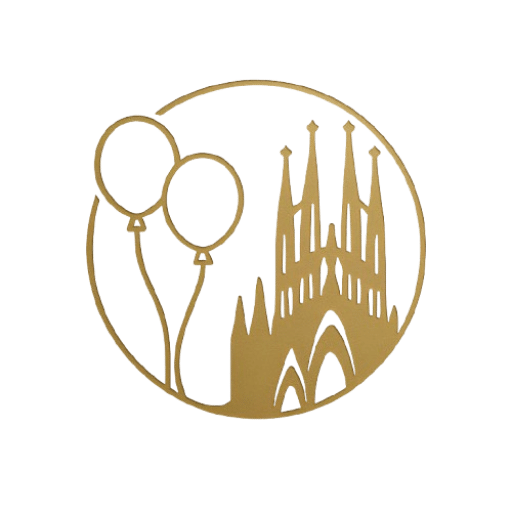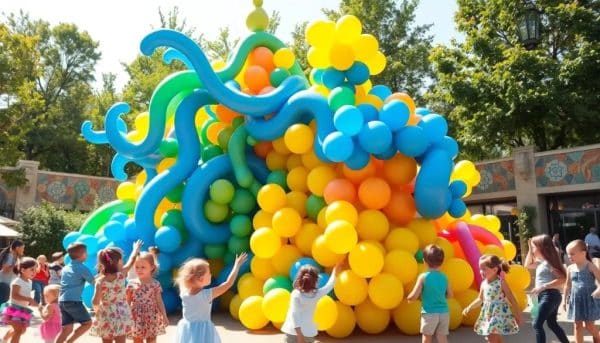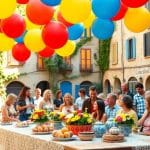- How are traditional Catalan elements integrated into modern balloon decoration?
- What is the significance of Palau de la Música Catalana in Catalan traditions?
- What makes Casa Batlló a key symbol of Catalan culture?
- How can Gaudí-inspired elements enhance balloon decoration?
- Why is it important for artists to understand Catalan architecture?
- What are the main characteristics of traditional Catalan design?
- What makes the trencadís technique unique in decorative arts?
- How can you participate in a Gaudí-inspired mosaic course?
- Related questions about Gaudí-inspired balloon art
In the vibrant world of balloon decoration, the influence of traditional Catalan elements has become increasingly prominent. This art form celebrates the rich heritage of Catalonia, drawing inspiration from its stunning architecture and cultural symbols. Gaudí-Inspired Balloon Art is at the forefront of this creative movement, combining traditional motifs with modern techniques.
By incorporating iconic features from Catalan architecture, such as the intricate designs of Antoni Gaudí, balloon artists can create stunning displays that honor local traditions while captivating audiences. This article will delve into how these elements are integrated into balloon decoration and highlight key architectural symbols that inspire contemporary artists.
How are traditional Catalan elements integrated into modern balloon decoration?
Modern balloon decoration often reflects the unique characteristics of traditional Catalan design. Artists blend vibrant colors, organic shapes, and intricate patterns to create visually striking pieces. This approach is deeply rooted in the architectural legacy of Catalonia, emphasizing the importance of context and history.
One of the most significant aspects of integrating traditional Catalan elements is the use of geometric motifs. These shapes can be mirrored in balloon arrangements, creating a connection between the artwork and the cultural heritage it represents. By carefully selecting colors that resonate with the Catalan landscape, artists can evoke a sense of place that enriches their work.
Additionally, artists often draw inspiration from natural forms, such as flowers and leaves, which are prevalent in Catalan architecture. Incorporating these organic shapes into balloon designs creates a harmonious blend of tradition and innovation, allowing for a fresh interpretation of age-old themes.
What is the significance of Palau de la Música Catalana in Catalan traditions?
The Palau de la Música Catalana is a UNESCO World Heritage site and a prime example of the architectural significance of Gaudí. Designed by architect Lluís Domènech i Montaner, this concert hall embodies the artistic spirit of Catalonia, showcasing the intricate designs that characterize the region's modernisme movement.
This iconic building serves as a centerpiece for Catalan cultural events, making it a vital hub for music and performance. Its elaborate stained glass, mosaic tiles, and sculptural details inspire artists across various disciplines, including balloon decoration. The vibrant atmosphere created by the Palau translates beautifully into balloon designs, infusing them with a sense of energy and cultural pride.
By referencing the Palau de la Música in their work, balloon artists reinforce the connection between music, culture, and visual art. This integration fosters a deeper appreciation for Catalan traditions and encourages a dialogue between the past and present.
What makes Casa Batlló a key symbol of Catalan culture?
Casa Batlló, another masterpiece by Antoni Gaudí, stands as a testament to the richness of Catalan culture. Its undulating forms, colorful façade, and intricate detailing reflect the essence of modernisme. This building not only captures the imagination but also embodies the cultural narrative of Catalonia.
The architectural elements of Casa Batlló, such as the organic shapes and vibrant mosaics, serve as inspiration for balloon artists. By incorporating similar patterns and colors into their creations, artists can create pieces that resonate with the distinctive beauty of this landmark.
Moreover, Casa Batlló illustrates the importance of storytelling in architectural design. Each detail conveys a narrative, encouraging artists to think creatively about how they can express similar themes through balloon art. This connection to Catalan culture enhances the emotional impact of balloon displays, making them more than just decorative elements.
How can Gaudí-inspired elements enhance balloon decoration?
Incorporating Gaudí-inspired elements into balloon decoration elevates the artistic quality of the work. The use of trencadís mosaic technique—a hallmark of Gaudí's style—provides a unique texture that can be replicated using balloons of various colors and patterns. This technique allows artists to create visually captivating designs that draw from the past while remaining relevant in contemporary contexts.
Moreover, the flowing lines and natural forms found in Gaudí's architecture can guide balloon placements, resulting in dynamic arrangements that mimic the essence of his work. By emulating these characteristics, artists can produce pieces that exude the organic beauty associated with Catalan modernisme.
Additionally, the incorporation of natural elements, such as floral designs or animal motifs, can enhance the overall aesthetic of balloon decorations. This approach not only honors Gaudí's legacy but also invites viewers to engage with the artwork on a deeper level, fostering a connection to the themes of nature and harmony.
Why is it important for artists to understand Catalan architecture?
Understanding Catalan architecture is crucial for artists aiming to create authentic and meaningful works. This knowledge provides a foundation for exploring the historical and cultural significance of elements like those found in Gaudí-Inspired Balloon Art. By delving into the architectural details, artists can enrich their designs, making them more reflective of Catalan identity.
Moreover, familiarity with the principles of Catalan modernisme allows artists to draw connections between their work and the broader cultural narrative. This understanding can inspire innovative techniques and encourage collaboration with other artists, further enhancing the richness of balloon decoration.
In essence, a strong grasp of Catalan architecture empowers artists to create pieces that resonate with audiences, fostering a sense of pride and appreciation for local traditions. By integrating these elements into their work, artists not only honor the past but also contribute to the ongoing evolution of Catalan culture.
What are the main characteristics of traditional Catalan design?
Traditional Catalan design is characterized by several key features that reflect the region's rich heritage. These characteristics include:
- Vibrant colors: Bold hues represent the lively spirit of Catalonia.
- Organic shapes: Curved lines and natural forms mimic the beauty of the surrounding landscape.
- Intricate patterns: Detailed motifs often draw inspiration from nature, adding depth and interest to designs.
- Use of materials: Traditional techniques prioritize the use of local materials, grounding the artwork in its cultural context.
These features come together to create a distinctive style that resonates with both locals and visitors. Artists who incorporate these elements into their balloon decoration can produce pieces that authentically reflect Catalan culture while appealing to a modern audience.
Furthermore, understanding these characteristics allows artists to experiment with different combinations, leading to innovative designs that celebrate the beauty of traditional Catalan art.
What makes the trencadís technique unique in decorative arts?
The trencadís technique is a remarkable mosaic art form that has become synonymous with Gaudí's work. It involves creating mosaic patterns from broken ceramic tiles, resulting in stunning compositions that boast both texture and color. This technique is particularly unique due to its emphasis on recycling materials, showcasing a commitment to sustainability in art.
In balloon decoration, artists can emulate the trencadís style by using balloons of various colors and sizes to create a mosaic effect. This approach not only pays homage to Gaudí but also allows for creative expression through the arrangement of colors and shapes.
Moreover, the versatility of the trencadís technique means that artists can adapt it to suit different themes and events. Whether for weddings, festivals, or corporate functions, incorporating this mosaic style can elevate balloon decorations, making them stand out and resonate with audiences.
How can you participate in a Gaudí-inspired mosaic course?
Participating in a Gaudí-inspired mosaic course can be an enriching experience for artists and art enthusiasts alike. These courses often focus on the trencadís technique, providing participants with hands-on experience in creating their own mosaic pieces. Many workshops are conducted in settings that celebrate Catalan culture, allowing participants to immerse themselves in the aesthetic and historical context of their work.
To find a suitable course, consider looking for local art schools, community centers, or specialized workshops that focus on mosaic art. Many of these programs offer flexible schedules and varying skill levels, making them accessible to everyone.
Engaging in a Gaudí-inspired mosaic course not only enhances artistic skills but also fosters a deeper appreciation for Catalonia's artistic legacy. Participants often leave with a sense of accomplishment and a collection of unique artworks that reflect their learning journey.
What are traditional Catalan elements in modern balloon decoration?
Traditional Catalan elements in modern balloon decoration include the use of vibrant colors, geometric shapes, and organic forms. Artists often draw inspiration from landmarks like the Sagrada Família and Casa Batlló, incorporating intricate patterns and local motifs into their designs. This blend of tradition and contemporary style creates visually striking balloon arrangements that celebrate Catalonia's cultural heritage.
How is the Palau de la Música Catalana relevant to Catalan traditions?
The Palau de la Música Catalana serves as a cultural beacon in Catalonia, representing the artistic values and traditions of the region. Its architectural beauty and significance as a performance space resonate deeply within Catalan culture. Artists often reference this landmark in their work, creating pieces that honor its legacy and contribute to the ongoing celebration of Catalan identity.
What makes Casa Batlló a symbol of Catalan culture?
Casa Batlló is a symbol of Catalan culture due to its unique architectural style, characterized by organic shapes, vibrant mosaics, and intricate details. Designed by Antoni Gaudí, this landmark embodies the spirit of modernisme and reflects the rich cultural narrative of Catalonia. Its significance inspires artists to create works that mirror its beauty and complexity, thus reinforcing the connection to local heritage.
How can traditional Catalan elements be incorporated into balloon decoration?
Traditional Catalan elements can be incorporated into balloon decoration through the use of vibrant colors, intricate patterns, and organic shapes. Artists can draw inspiration from Catalan architecture and local motifs, creating designs that celebrate the region's cultural heritage. This approach not only enhances the visual appeal of balloon displays but also fosters a deeper connection to Catalonia's artistic legacy.
Why is understanding Catalan architecture important for artists?
Understanding Catalan architecture is important for artists because it informs their creative practices and enriches their work. By studying the principles of Catalan design and the significance of its landmarks, artists can create more authentic and meaningful pieces. This knowledge also fosters an appreciation for local traditions, encouraging artists to engage with the cultural narrative of their environment.
What are the key features of traditional Catalan design?
The key features of traditional Catalan design include vibrant colors, organic shapes, intricate patterns, and a focus on local materials. These elements work together to create a distinctive style that reflects the region's cultural heritage. Artists who incorporate these characteristics into their balloon decorations can produce works that resonate with both local and global audiences, celebrating the beauty of Catalan art.
Please note that all prices displayed on this website are for reference only. Final pricing may vary depending on the specific decoration requirements, materials, and event details. Contact us for a personalized quote tailored to your unique celebration!



Deja una respuesta